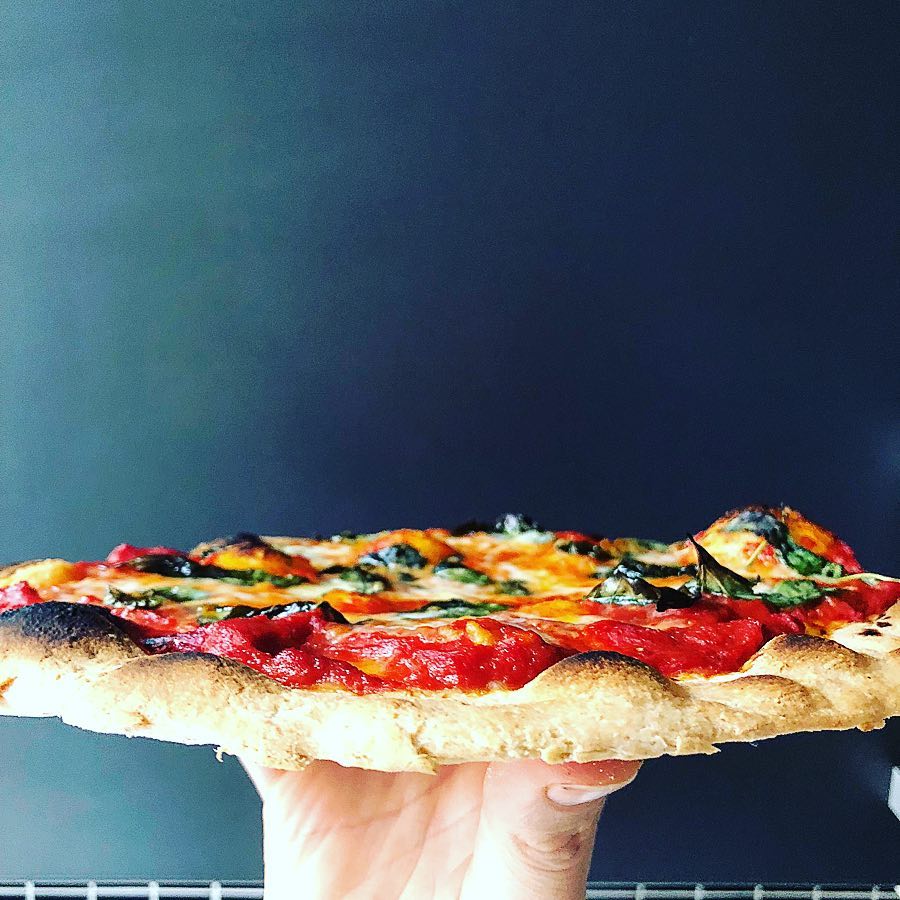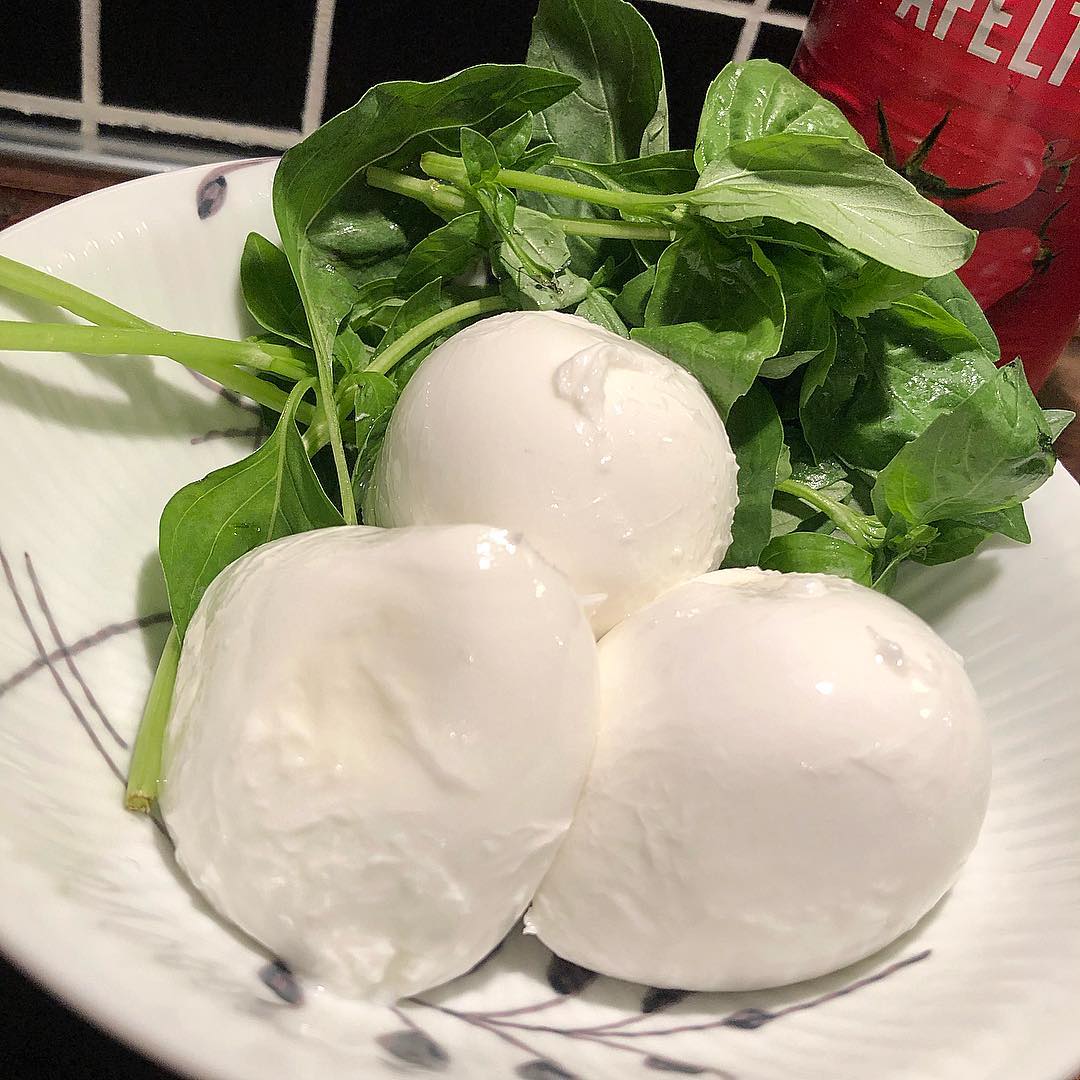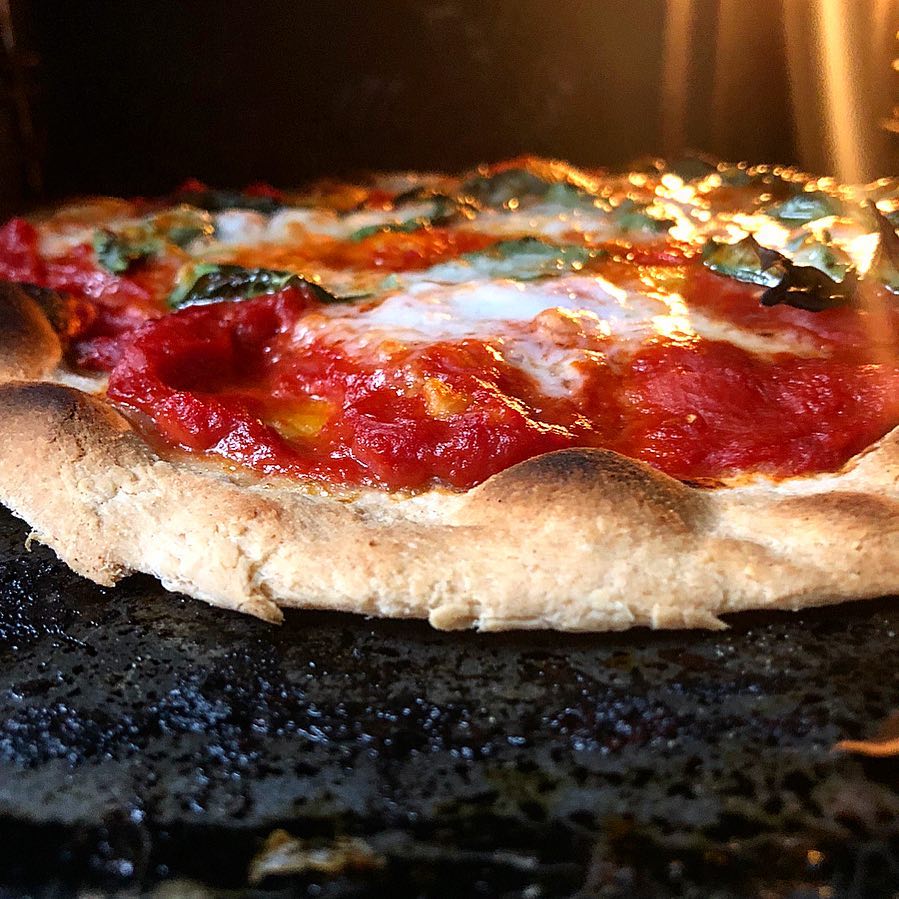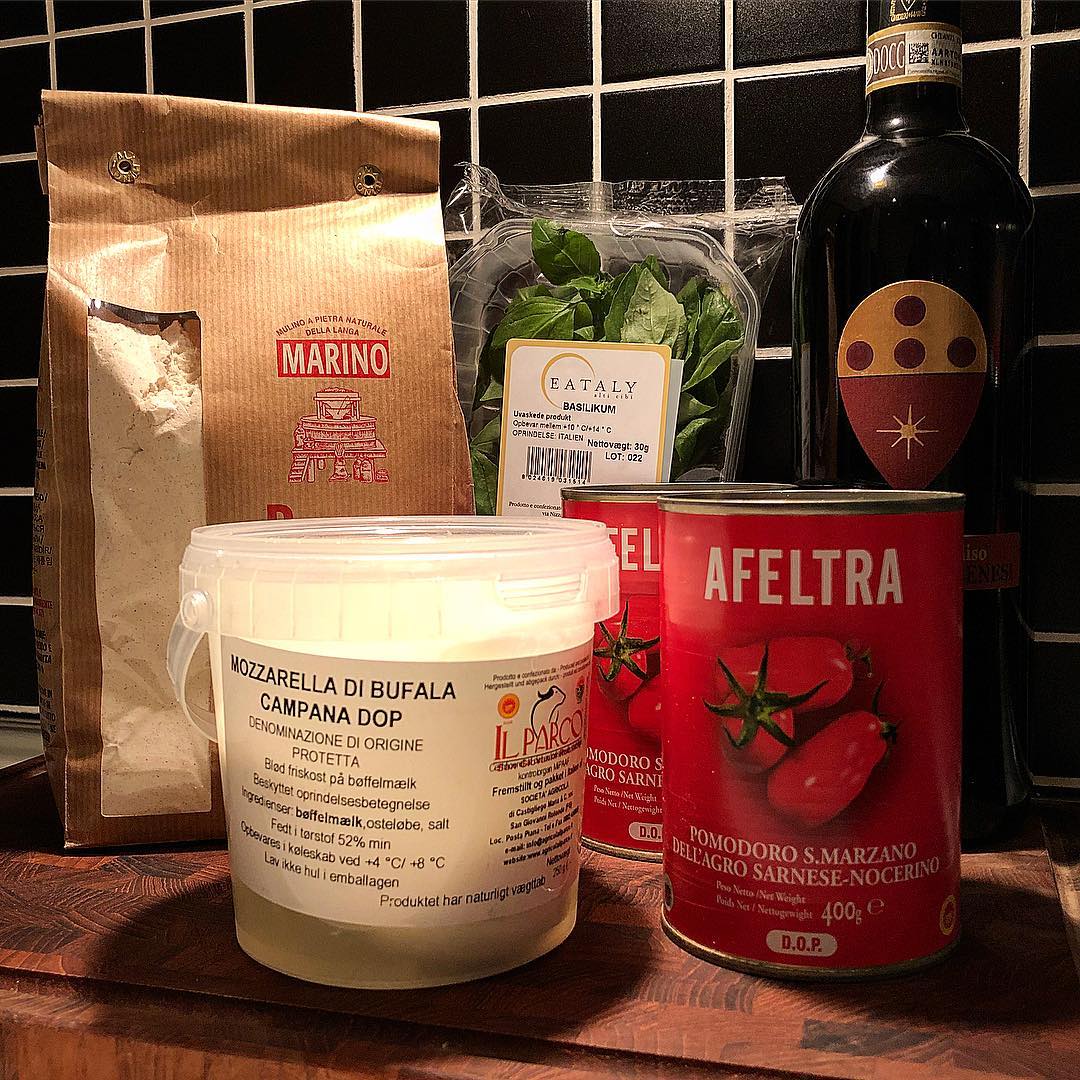Imagine, if you will, a life without pizza (I know you don’t want to!)… That was my life for a few years. Crazy, you say? But imagine then, if you will, a life with only bad pizza. Which one, I ask you, is worse?
Sadly, there’s a lot of bad pizza in this world, and in this town particularly. Most of it not worth eating. Only in recent years have we seen a few skilled pizza masters set up shop in town and in the years before that, the lowest common denominator ruled supreme: people wanted cheap pizza and they wanted large meat lover-like portions. Needless to say, if you want a lot of something for next to no money, the result is going to be pretty terrible. I, being the picky foodie that I am, wanted none of it, so I actually kept off pizza for quite a few years!

The perfect home-made pizza? Well, it’s good enough for me!
But pray tell, Johan, why not just make your own pizza? Well, the sad fact of the matter was –and this thoroughly pissed me off, by the way – that I was not necessarily better at making pizza at home than the amateurs trying their luck at the downtown pizzerias. And it was not out of lack of trying. Believe you me, I tried for years – and failed miserably. To a point where I just gave up! In the end, I literally went years without good pizza, a torturous experience I don’t wish upon my worst enemy.
Eventually, though, after years of utter misery and failure, I said to myself: You know what, myself? Anyone should be able to make great pizza at home, the Italians have been doing it for centuries, it can’t be THAT hard!
Thus began another quest for perfection in my life, a quest for the perfect home-made pizza. For months, if not years, I plowed through books, the internet, TV shows, magazines, restaurants and the knowledge of ancient masters. I picked up various tips, tricks and ideas, brought them home, tried them out, noted what worked, threw out what didn’t and, eventually, after only a few years of trial and error, I was able to achieve pretty decent results every time. Have I mentioned, by the way, that I sometimes obsess about things?
In my quest for perfection, I’ve learned quite a few things, tried and tested a lot of thoughts and theories, made a lot of mistakes, burnt myself a few times and, eventually, figured out how to do a very respectable pizza. In the process, I’ve created a rule set for pizza making, consisting of six very basic rules that I feel everyone should adhere to.

Mmm… Crispy…
For those who also wish to attain home-made pizza Nirvana, I present these to you below, starting with the all-important albeit somewhat controversial rule #1:
Rule #1: Toppings do not a good pizza make!
“Now, here’s a theory for you to completely disregard…” (Bonus points to whoever nails the reference!): Toppings do not a great pizza make! True, toppings are marvelous things, but some people put way too much thought and focus into toppings. They pile them on, seven layers strong and turn their pizza into a mushy landslide of clashing flavors. And it’s a damn shame. A great pizza should be about the dough: a thin, crispy, flavorful, golden brown and wonderful delivery vessel for a few select, high-quality toppings.
Therefore, this post is not so much about toppings as it is about creating the perfect pizza dough; a process that is both labor intensive and time consuming, but well worth it in the end.
There really are no great secrets involved in making perfect pizza dough. The ingredients are few, simple and all listed in the recipe found at the end of this post. I do, however, have a three very simple tips that will make your perfect pizza dough even better:
- For your flour, use high protein flour – we need as much protein as we can get in order to produce a good crust and a light, chewy dough. Try to find something with a 12-14% protein content.
- Salt your dough and use more salt than you think you need – Nothing tastes more bland and disappointing than unsalted dough. This is a fact of life. Salt your dough generously.
- It’s okay to use instant yeast for pizza, but yeast likes to eat well, so throw them some sort of sugar to metabolize and turn into lift and flavor – I use a half and half mix of raw cane sugar and honey, they seem to enjoy that. I’ve no proof this makes for a better pizza dough, but why wouldn’t it? Besides, I don’t allow refined sugar in my kitchen, so I make do with what I have.
PRO TIP ON CHOSING THE RIGHT FLOUR: Some readers have reported slight problems with the elasticity of their dough. After kneading and resting, it had a tendency to spring back when formed into a pizza. I’ve recently had this happen to myself and have pinpointed the flour as the culprit. Certain types of flours seem to have a tendency towards elasticity but I’m not yet entirely sure which or why. I know of one that does work, though!
When looking for flour for pizza, I now go for packages specifically labeled as “Pizza flour”. When I find one, I carefully look at the description on the back and make sure it’s make of 100% Italian wheat flour and labeled as either TIPO 0 or TYPE 0. This particular type of flour works for me every time and makes for a lovely tasty, crusty yet chewy pizza crust. Do take care, though, the package says TIPO 0 not TIPO 00, a different type of Italian (Durum) wheat flour which in my book does not make a good pizza, but a rather lovely pasta.
Rule #2: Less is more!
Toppings do not a pizza make, he said, but that’s not to say they’re not important! Pizzas are an Italian invention, Italians believe in simplicity. That is: few ingredients, limited quantities, high quality. And there’s a great lesson to be learned here: If you use really high quality ingredients, you don’t need a lot of each for the flavor to really shine through. Plus if you don’t use too many ingredients, you’re less likely to have the subtle nuances of one ingredient getting lost in the complexity of others. Clever people, those Italians!

When topping off your pizza, less is definitely more! You don’t need a lot of ingredients, you simply need the best!
My rule of thumb? Aside from the obligatory tomato, cheese and herbs, try to stick stick to no more than two or three toppings and do try to use them sparingly. For a few ingredient suggestions, see the end of this post.
Rule #3: When the going gets tough, the tough gets kneading!
I’m almost sorry to have to tell you this, but if you want top shelf pizza in the comfort of your own home, you’re going to have to be prepared to do a bit of kneading. Pizza dough should be kneaded for no less than 20 minutes, longer would be preferable. Kneading develops gluten which adds elasticity and airiness, two things that we definitely want, nay need, in a perfect pizza! For kneading purposes, you can either use a stand mixer or use your hands and think of it as therapy. I always use my hands, usually on a Friday night and knead away for about 30 minutes with minor breaks while I get any possible accumulated frustrations or remaining work thoughts out of my head.
Rule #4: Time is of the essence
If you thought the kneading process took time, wait till you hear about the rising period. Rising does two things: first and foremost, it develops gas that makes the dough light and airy, secondly, but possibly most importantly, it develops flavor through the process of fermentation.
We’ve been over this once already in our Brioche recipe, but basically the longer the dough rises the more bready and complex the taste. I’ve done some very unscientific experiments with rising time and basically what it boils down to is that a 24 hour rise makes for a wonderful pizza.
I’ve been known to try 48 hours as well and, well, it certainly didn’t make for a worse pizza, but it did make for a pretty long wait. For the standard home chef, 24 hours is just fine. The differences are certainly noticeable, and I do encourage you to try, but it’s a hell of a long wait, though, if patience is not really your thing.
Rule #5: Don’t roll, stretch! … or toss if you dare!
When rising is taken care of and it comes to actually flattening your dough into a bakeable disk, the methods and opinions are many, and tempers have flared in discussions over preferences. Some use a rolling pin, some use their hands, some say the dough must be tossed (and they’re better men than me!). Despite the heading, I tend to say that you should do as you feel most comfortable doing.
You’ll certainly get the best results using your hands, but if a rolling pin makes you more comfortable, then use that, it beats messing up the pizza or getting frustrated from not being able to get it right. Know this, though, using your hands will make it easier for you to make a perfect crust around the rim of the pizza because it won’t be squashed as flat as if you were using a rolling pin. So, stretching pizza by hand is definitely a skill to pursue.
As for tossing? Well, it’s not actually only something pizza bakers do for show! If the dough is stretchy and flexible enough, spinning it in the air and catching it with your knuckles in the center actually will help stretch the dough very nicely and evenly. It does, however, also greatly increase the risk of you dropping the dough on the floor and/or looking like an idiot. So toss at your own risk and use caution!
Rule #6: High heat!
For a pizza to really bake properly, it needs a short burst and direct burst of high heat, and that’s sadly pretty difficult in a home oven. The trouble with domestic ovens is that they don’t really get very hot as compared to professional ovens. Most max out at around 250 degrees C while some claim to go as high as 300 degrees but seldom really do. The solution? A pizza stone! You can get these for next to nothing at your local kitchen supply store, or even less if you can pick up an ordinary, heat-proof piece of unglazed, flat piece of stone or tile that fits your oven.

Burn, baby, burn!
If you’re serious about pizza, a pizza stone will set you free! It warms slowly along with the oven, but helps retain the heat and temperature of the oven all while delivering it swiftly to the base of the pizza as soon as it hits the stone. Your pizza will bake in less time and the bottom will be brown, crusty and crispy since it bakes directly on the naked stone.
When baking using a pizza stone, get the oven as high as it will go, turn on the oven fan if you have one, turn on the broiler if you must, light a fire (seriously, don’t light a fire in your oven, if you do you will get hurt and will sue me for all I own, which is nothing) and bake the living daylights out of that piece of stone. Get the oven to max heat and keep it there for a good while before sliding your pizza onto the stone, and…
Watch it! We’re dealing with a pretty damn hot oven here and things can go from crisp to burnt pretty damn quickly, so keep an eye on things, watch for browning and signs of smoke and be ready to rotate pizza if browning happens unevenly. Bake pizza till top is golden brown and bubbly. I can’t really give you a time estimate here, as no two ovens are alike. You’ll have to use your senses, great huh?
Alright, got all that? These rules are all fine and dandy, I hear you saying, but what about the recipe to put words into action? Well, look no further, my friends, here it is. The perfect pizza recipe:

Perfect pizza dough
Ingredients
- 4 tablespoons sugar
- 2 tablespoons kosher salt
- 2 tablespoons olive oil
- 250 ml warm water add more if needed
- 500 grams bread flour by weight
- 2 teaspoons instant yeast
Instructions
-
In a bowl or stand mixer, add all the dry ingredients, then form a mound in the center and pour in warm water and olive oil.
-
Using your hands or the paddle attachment of your mixer, mix ingredients until the dough comes together. If dough is too dry and doesn't come together properly, gradually add a little more water.
-
When dough comes together either tip onto a well-floured counter and knead by hand, or switch to the dough hook attachment of your mixer (the latter would be cheating).
-
Knead dough for AT LEAST 15 minutes if using a mixer.
-
If using your hands, knead for a full ten minutes, take a two minute pause, knead another ten minutes, take a two minute pause and, finally, knead another ten minutes.
-
If you go by hand, you may have to add more flour as you go to keep the dough from sticking. Use as little as possible here.
-
After 15-30 minutes of kneading (depending on method used), tear off a small piece of dough and flatten into a disc.
-
Stretch the dough until thin and hold it up to the light and look to see if the baker’s windowpane, or taut membrane, has formed. That is, if you’re basically able to see the light through the dough.
-
If the dough tears, knead the dough for an additional 5 to 10 minutes. Fun, huh?
-
Roll the pizza dough into a smooth ball on the countertop. Then place the dough ball in a bowl. Add a couple of teaspoons of olive oil to the bowl and toss to coat. Cover with plastic wrap and refrigerate for at least 18 to 24 hours. 36-48 is okay.
-
Remove dough from fridge about an hour before baking time to let it come up to temperature a bit.
-
Halve or quarter the dough as you see fit and roll each portion into a ball of its own.
-
To make pizza, press down with your palm on top of a ball of dough to form a disc.
-
Using the palms of your hands, press down on the disc and slowly press, pull and roatet it into a thin pizza base. This takes some practice. If you’re really bold, you can toss it in the air as well.
-
If you’re really having trouble getting your pizza thin and nice, you can use a rolling pin. Purists will scoff, but what’re they gonna do?
-
Top pizza with tomato sauce, your favorite cheese and toppings of choice, then slide into a hot oven and bake until base is crunchy and toppings are a golden brown and delicious mess.
Topping suggestions
I know I said in the beginning of my post that toppings do not a great pizza make. Toppings, however, are a very important part of any good pizza.

In the end, you can top a pizza with just about anything, but I have a couple of personal favorites that I keep coming back to.
Classic Margarita: Tomato, Buffalo Mozzarella and fresh basil
This pizza is the essence of simplicity, but still remains one of my favorite pizza experiences of all time. Because it’s so simple, the trick here is to find the best possible ingredients. Make a tomato sauce using the best tomatoes you can find; fresh when in season, otherwise canned. Smear it on the pizza base and add rich, creamy buffalo mozzarella and fresh basil. Now bake, remove from oven and enjoy. That’s all. No, really. Enjoy.
Buffalo Mozzarella, Parma ham, Parmesan and arugula salad
Another favorite pizza of mine. Begin as you would with a simple Margarita. Add tomato sauce and buffalo mozzarella to pizza base, then bake. While pizza bakes, find a few slices of Parma ham (I use a spectacular 24 month variety that literally melts in the mouth) and make a fair bit of Parmesan cheese shavings (use the real stuff, that goes for the Parma ham as well). When pizza is baked, remove from oven and immediately place strips of Parma ham on top so it melts slightly into the base. Top with Parmesan shavings, arugula, black pepper and extra virgin olive oil.
Buffalo Mozzarella, Chorizo, bell pepper, Sriracha hot sauce
As above, start with tomato sauce and cheese, pop in oven and bake. A few minutes before pizza is done, add thin slices of Chorizo (spicy, paprika-laden, Spanish sausage similar to a cured salami), slivers of red bell pepper and as much Sriracha hot sauce as you can stomach. Adding the final ingredients at the end will prevent them from burning in the intense heat of the oven. This, by the way, is a rather new addition to my lineup of pizzas, born from my love and fascination with one of the world’s truly great condiments: Sriracha chili sauce. For my pizzas, I naturally use my own home-made Sriracha sauce.
Spicy lamb, feta cheese, Moroccan mint, Ghost Chili hot sauce and wild garlic
I’m well aware that lamb on pizza sounds a little odd to the average palate, especially with the addition of feta cheese and herbs. But trust me on this one! I came up with this over Easter, heavily influenced by Middle Eastern flat-breads and Mediterranean influences. The results were so good, in fact, that they made it into a post of their own which you can read here in its entirety.
Those are but four of my favorite topping combinations. The possibilities, as they say, are endless! I hope I’ve inspired you to thoroughly complicate a timeless classic and give slow-risen pizza a go. And with that, I’ll leave you with the best wishes and a question:
What are YOUR all time favorite pizza toppings? Let us know in the comments below, we all may learn something!
I always use tipo 00 flour and I also have a little issue with elasticity. However, my pizzas always end up near perfect but next time I will try to use a tipo 0 flour for the dough and see if it makes any difference for me. Also, you are right: The Italians are genius! Less is always more!
Your pizzas sure look awesome, Martin! And I agree they’ll turn out pretty good with Tipo 00 or even regular bread flour (and a bit of work). For some reason, though, I was just never a big fan of Tipo 00 for pizza. Sacrilege, I know. Please let me know how your experiment turns out 🙂